Sustainability Practices and Stakeholder Management at Kakadu National Park
VerifiedAdded on 2023/06/11
|11
|2901
|250
AI Summary
This report analyzes the sustainability practices and stakeholder management at Kakadu National Park, Australia. It provides logical recommendations for stakeholder management to cope up with the issues and preservation of the natural resources.
Contribute Materials
Your contribution can guide someone’s learning journey. Share your
documents today.
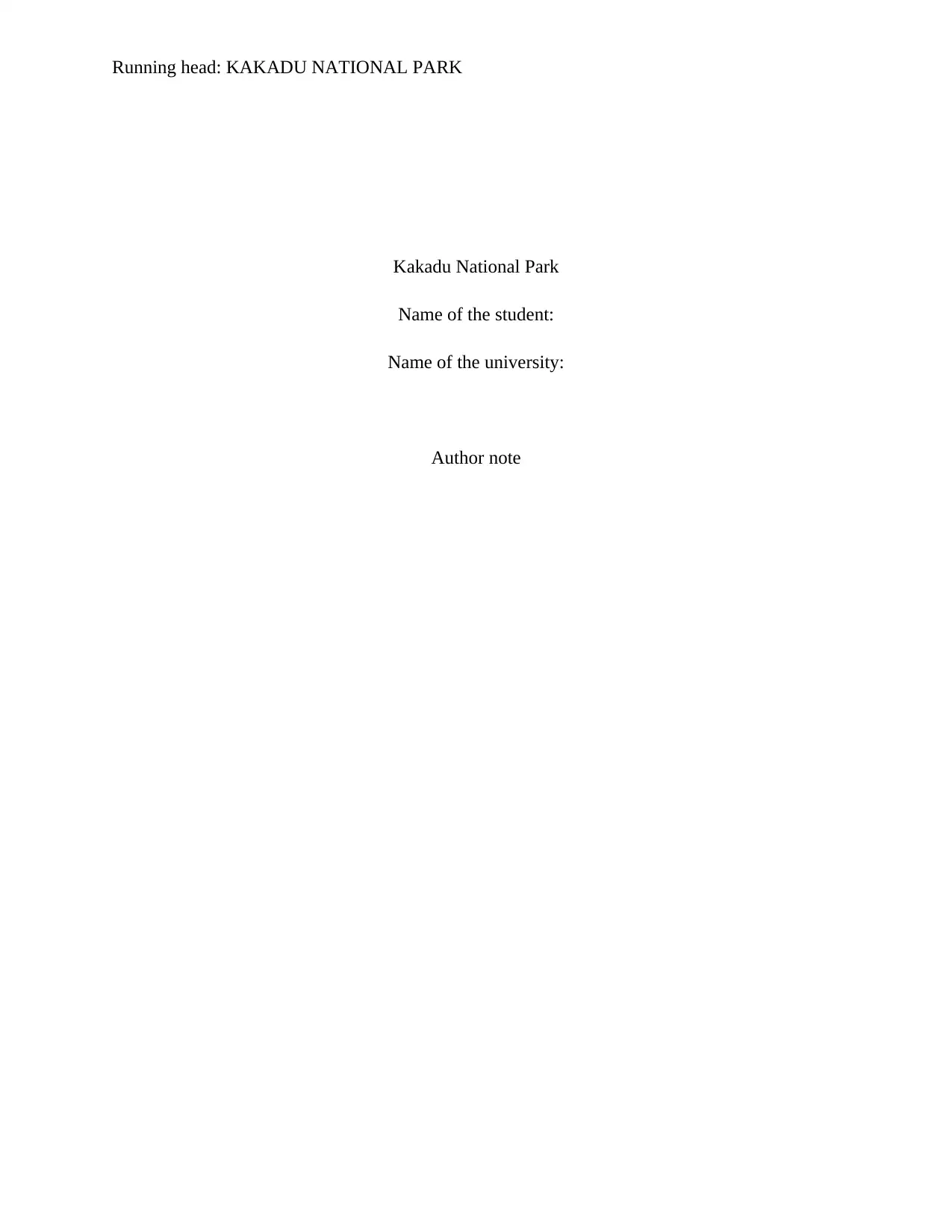
Running head: KAKADU NATIONAL PARK
Kakadu National Park
Name of the student:
Name of the university:
Author note
Kakadu National Park
Name of the student:
Name of the university:
Author note
Secure Best Marks with AI Grader
Need help grading? Try our AI Grader for instant feedback on your assignments.
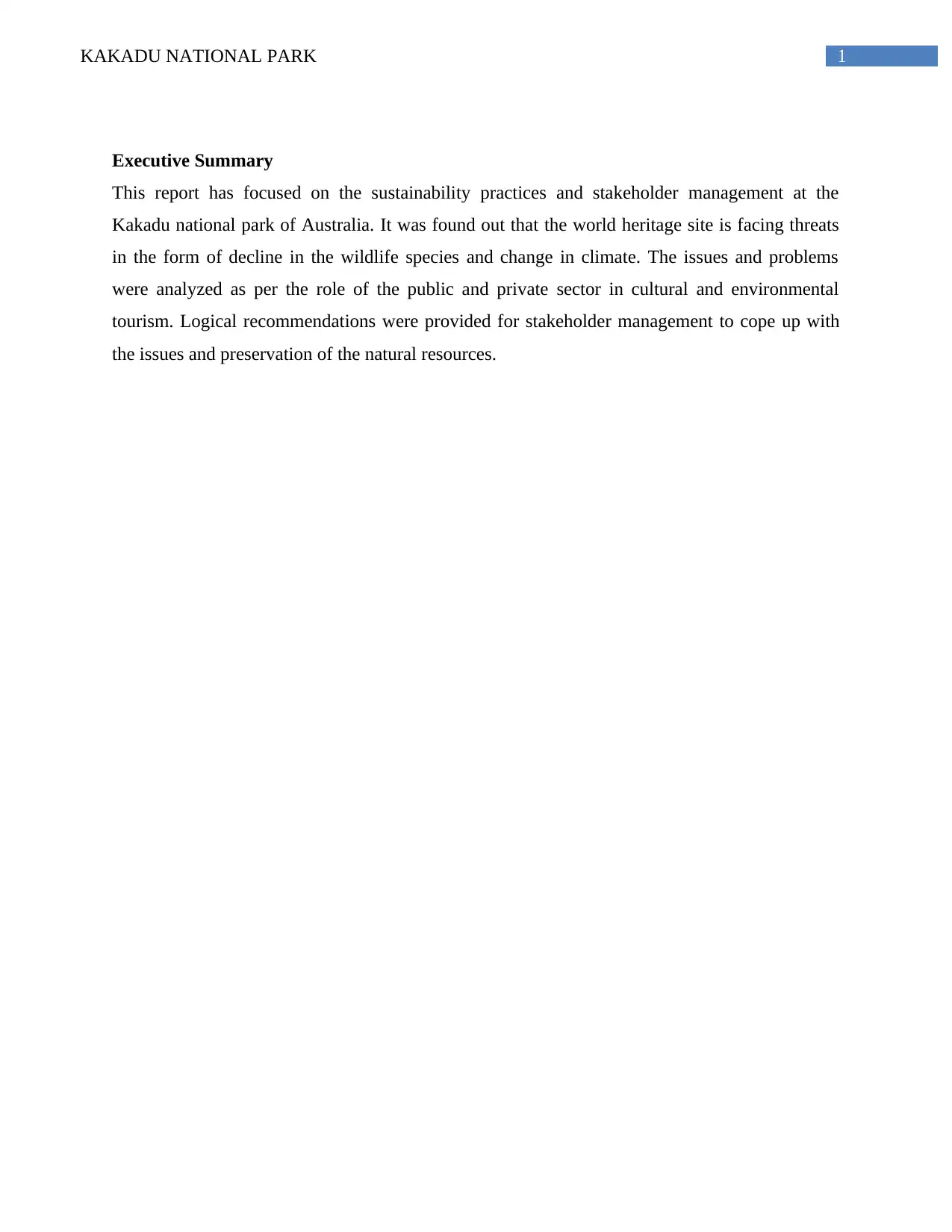
1KAKADU NATIONAL PARK
Executive Summary
This report has focused on the sustainability practices and stakeholder management at the
Kakadu national park of Australia. It was found out that the world heritage site is facing threats
in the form of decline in the wildlife species and change in climate. The issues and problems
were analyzed as per the role of the public and private sector in cultural and environmental
tourism. Logical recommendations were provided for stakeholder management to cope up with
the issues and preservation of the natural resources.
Executive Summary
This report has focused on the sustainability practices and stakeholder management at the
Kakadu national park of Australia. It was found out that the world heritage site is facing threats
in the form of decline in the wildlife species and change in climate. The issues and problems
were analyzed as per the role of the public and private sector in cultural and environmental
tourism. Logical recommendations were provided for stakeholder management to cope up with
the issues and preservation of the natural resources.
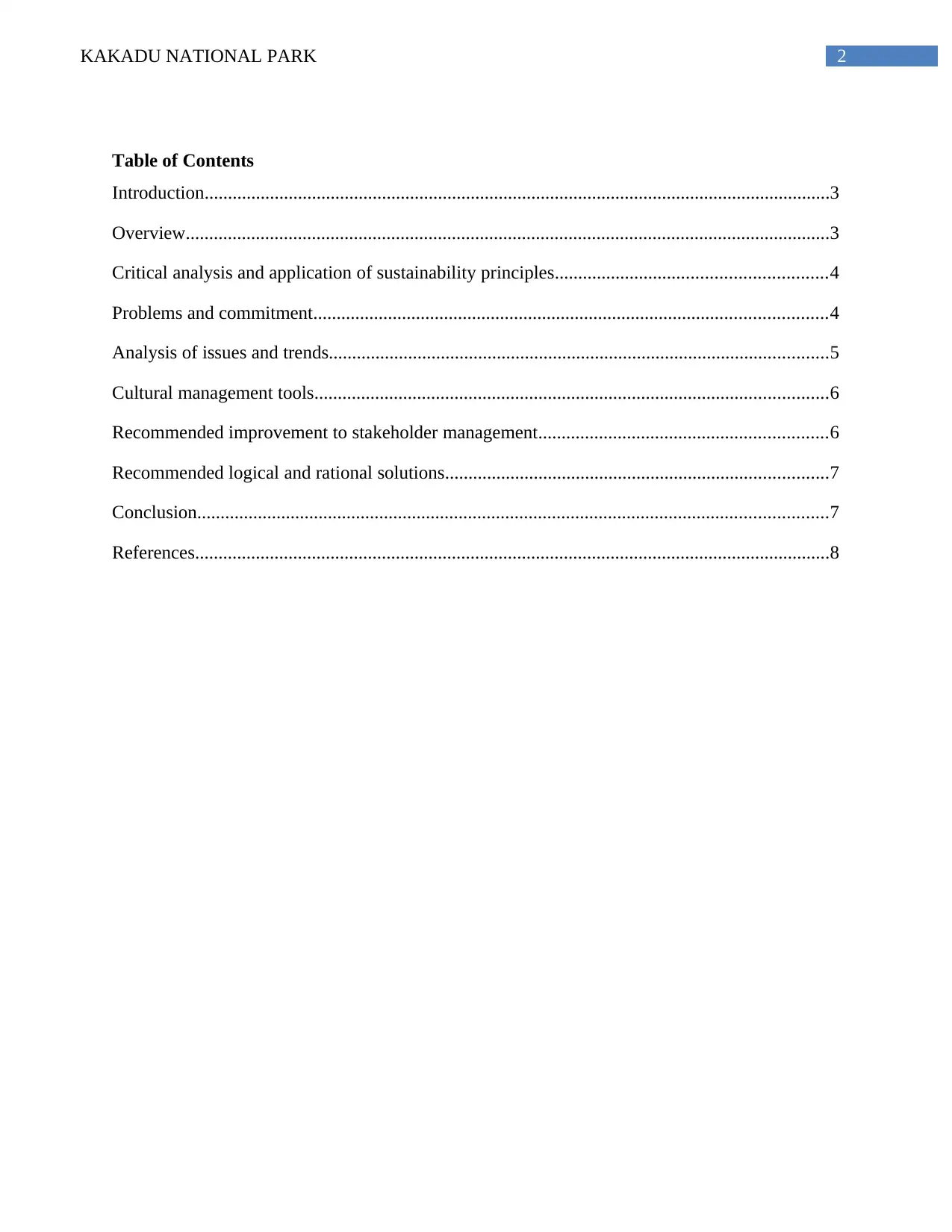
2KAKADU NATIONAL PARK
Table of Contents
Introduction......................................................................................................................................3
Overview..........................................................................................................................................3
Critical analysis and application of sustainability principles..........................................................4
Problems and commitment..............................................................................................................4
Analysis of issues and trends...........................................................................................................5
Cultural management tools..............................................................................................................6
Recommended improvement to stakeholder management..............................................................6
Recommended logical and rational solutions..................................................................................7
Conclusion.......................................................................................................................................7
References........................................................................................................................................8
Table of Contents
Introduction......................................................................................................................................3
Overview..........................................................................................................................................3
Critical analysis and application of sustainability principles..........................................................4
Problems and commitment..............................................................................................................4
Analysis of issues and trends...........................................................................................................5
Cultural management tools..............................................................................................................6
Recommended improvement to stakeholder management..............................................................6
Recommended logical and rational solutions..................................................................................7
Conclusion.......................................................................................................................................7
References........................................................................................................................................8
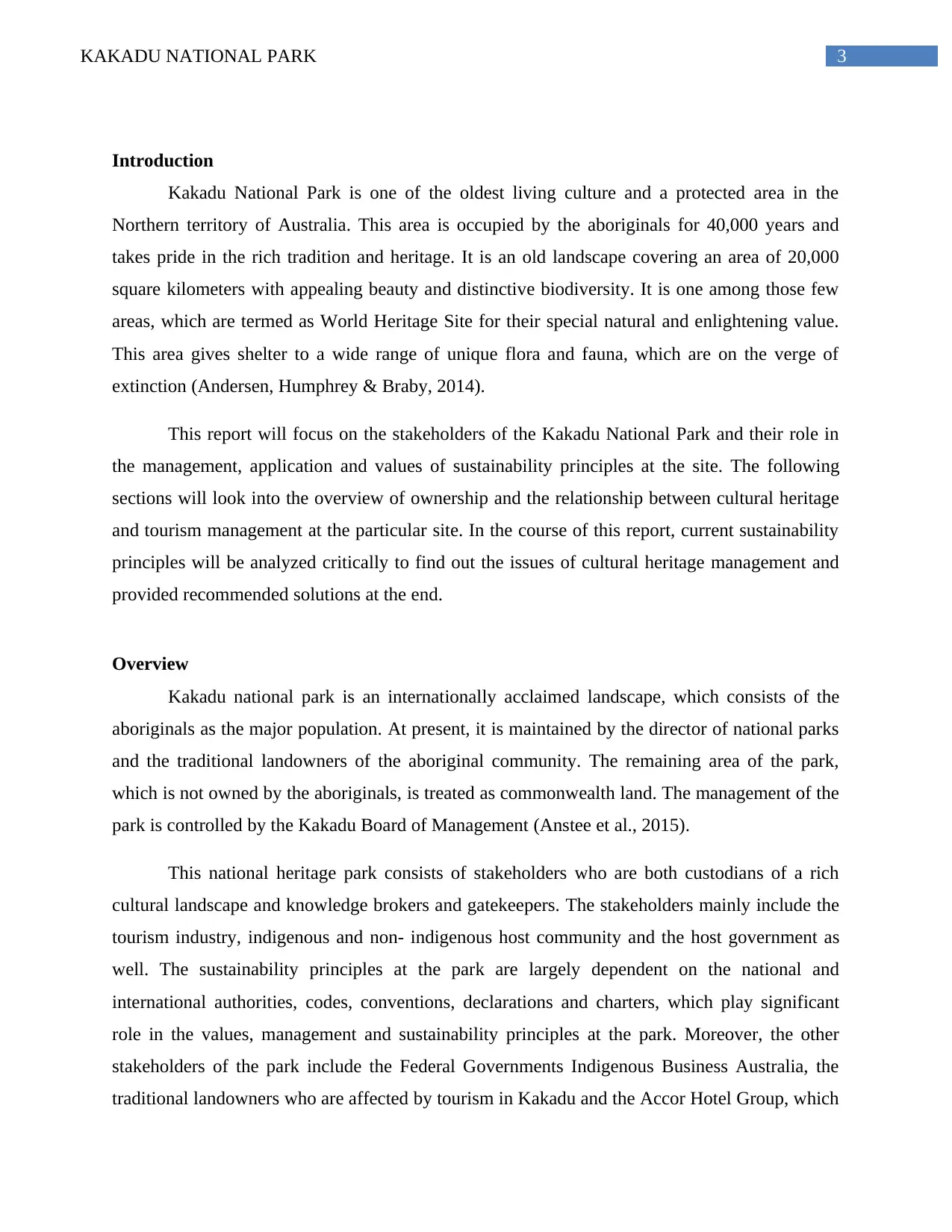
3KAKADU NATIONAL PARK
Introduction
Kakadu National Park is one of the oldest living culture and a protected area in the
Northern territory of Australia. This area is occupied by the aboriginals for 40,000 years and
takes pride in the rich tradition and heritage. It is an old landscape covering an area of 20,000
square kilometers with appealing beauty and distinctive biodiversity. It is one among those few
areas, which are termed as World Heritage Site for their special natural and enlightening value.
This area gives shelter to a wide range of unique flora and fauna, which are on the verge of
extinction (Andersen, Humphrey & Braby, 2014).
This report will focus on the stakeholders of the Kakadu National Park and their role in
the management, application and values of sustainability principles at the site. The following
sections will look into the overview of ownership and the relationship between cultural heritage
and tourism management at the particular site. In the course of this report, current sustainability
principles will be analyzed critically to find out the issues of cultural heritage management and
provided recommended solutions at the end.
Overview
Kakadu national park is an internationally acclaimed landscape, which consists of the
aboriginals as the major population. At present, it is maintained by the director of national parks
and the traditional landowners of the aboriginal community. The remaining area of the park,
which is not owned by the aboriginals, is treated as commonwealth land. The management of the
park is controlled by the Kakadu Board of Management (Anstee et al., 2015).
This national heritage park consists of stakeholders who are both custodians of a rich
cultural landscape and knowledge brokers and gatekeepers. The stakeholders mainly include the
tourism industry, indigenous and non- indigenous host community and the host government as
well. The sustainability principles at the park are largely dependent on the national and
international authorities, codes, conventions, declarations and charters, which play significant
role in the values, management and sustainability principles at the park. Moreover, the other
stakeholders of the park include the Federal Governments Indigenous Business Australia, the
traditional landowners who are affected by tourism in Kakadu and the Accor Hotel Group, which
Introduction
Kakadu National Park is one of the oldest living culture and a protected area in the
Northern territory of Australia. This area is occupied by the aboriginals for 40,000 years and
takes pride in the rich tradition and heritage. It is an old landscape covering an area of 20,000
square kilometers with appealing beauty and distinctive biodiversity. It is one among those few
areas, which are termed as World Heritage Site for their special natural and enlightening value.
This area gives shelter to a wide range of unique flora and fauna, which are on the verge of
extinction (Andersen, Humphrey & Braby, 2014).
This report will focus on the stakeholders of the Kakadu National Park and their role in
the management, application and values of sustainability principles at the site. The following
sections will look into the overview of ownership and the relationship between cultural heritage
and tourism management at the particular site. In the course of this report, current sustainability
principles will be analyzed critically to find out the issues of cultural heritage management and
provided recommended solutions at the end.
Overview
Kakadu national park is an internationally acclaimed landscape, which consists of the
aboriginals as the major population. At present, it is maintained by the director of national parks
and the traditional landowners of the aboriginal community. The remaining area of the park,
which is not owned by the aboriginals, is treated as commonwealth land. The management of the
park is controlled by the Kakadu Board of Management (Anstee et al., 2015).
This national heritage park consists of stakeholders who are both custodians of a rich
cultural landscape and knowledge brokers and gatekeepers. The stakeholders mainly include the
tourism industry, indigenous and non- indigenous host community and the host government as
well. The sustainability principles at the park are largely dependent on the national and
international authorities, codes, conventions, declarations and charters, which play significant
role in the values, management and sustainability principles at the park. Moreover, the other
stakeholders of the park include the Federal Governments Indigenous Business Australia, the
traditional landowners who are affected by tourism in Kakadu and the Accor Hotel Group, which
Secure Best Marks with AI Grader
Need help grading? Try our AI Grader for instant feedback on your assignments.
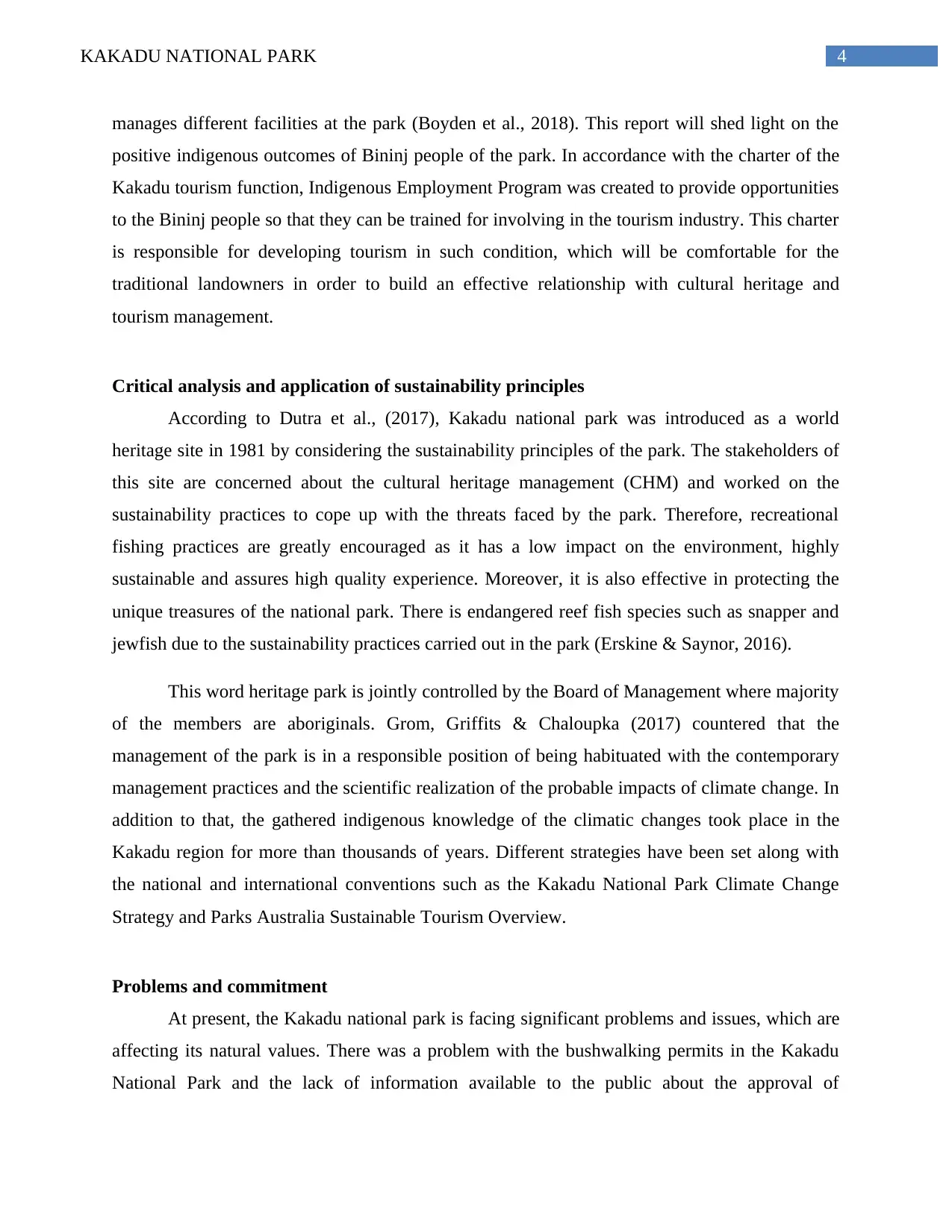
4KAKADU NATIONAL PARK
manages different facilities at the park (Boyden et al., 2018). This report will shed light on the
positive indigenous outcomes of Bininj people of the park. In accordance with the charter of the
Kakadu tourism function, Indigenous Employment Program was created to provide opportunities
to the Bininj people so that they can be trained for involving in the tourism industry. This charter
is responsible for developing tourism in such condition, which will be comfortable for the
traditional landowners in order to build an effective relationship with cultural heritage and
tourism management.
Critical analysis and application of sustainability principles
According to Dutra et al., (2017), Kakadu national park was introduced as a world
heritage site in 1981 by considering the sustainability principles of the park. The stakeholders of
this site are concerned about the cultural heritage management (CHM) and worked on the
sustainability practices to cope up with the threats faced by the park. Therefore, recreational
fishing practices are greatly encouraged as it has a low impact on the environment, highly
sustainable and assures high quality experience. Moreover, it is also effective in protecting the
unique treasures of the national park. There is endangered reef fish species such as snapper and
jewfish due to the sustainability practices carried out in the park (Erskine & Saynor, 2016).
This word heritage park is jointly controlled by the Board of Management where majority
of the members are aboriginals. Grom, Griffits & Chaloupka (2017) countered that the
management of the park is in a responsible position of being habituated with the contemporary
management practices and the scientific realization of the probable impacts of climate change. In
addition to that, the gathered indigenous knowledge of the climatic changes took place in the
Kakadu region for more than thousands of years. Different strategies have been set along with
the national and international conventions such as the Kakadu National Park Climate Change
Strategy and Parks Australia Sustainable Tourism Overview.
Problems and commitment
At present, the Kakadu national park is facing significant problems and issues, which are
affecting its natural values. There was a problem with the bushwalking permits in the Kakadu
National Park and the lack of information available to the public about the approval of
manages different facilities at the park (Boyden et al., 2018). This report will shed light on the
positive indigenous outcomes of Bininj people of the park. In accordance with the charter of the
Kakadu tourism function, Indigenous Employment Program was created to provide opportunities
to the Bininj people so that they can be trained for involving in the tourism industry. This charter
is responsible for developing tourism in such condition, which will be comfortable for the
traditional landowners in order to build an effective relationship with cultural heritage and
tourism management.
Critical analysis and application of sustainability principles
According to Dutra et al., (2017), Kakadu national park was introduced as a world
heritage site in 1981 by considering the sustainability principles of the park. The stakeholders of
this site are concerned about the cultural heritage management (CHM) and worked on the
sustainability practices to cope up with the threats faced by the park. Therefore, recreational
fishing practices are greatly encouraged as it has a low impact on the environment, highly
sustainable and assures high quality experience. Moreover, it is also effective in protecting the
unique treasures of the national park. There is endangered reef fish species such as snapper and
jewfish due to the sustainability practices carried out in the park (Erskine & Saynor, 2016).
This word heritage park is jointly controlled by the Board of Management where majority
of the members are aboriginals. Grom, Griffits & Chaloupka (2017) countered that the
management of the park is in a responsible position of being habituated with the contemporary
management practices and the scientific realization of the probable impacts of climate change. In
addition to that, the gathered indigenous knowledge of the climatic changes took place in the
Kakadu region for more than thousands of years. Different strategies have been set along with
the national and international conventions such as the Kakadu National Park Climate Change
Strategy and Parks Australia Sustainable Tourism Overview.
Problems and commitment
At present, the Kakadu national park is facing significant problems and issues, which are
affecting its natural values. There was a problem with the bushwalking permits in the Kakadu
National Park and the lack of information available to the public about the approval of
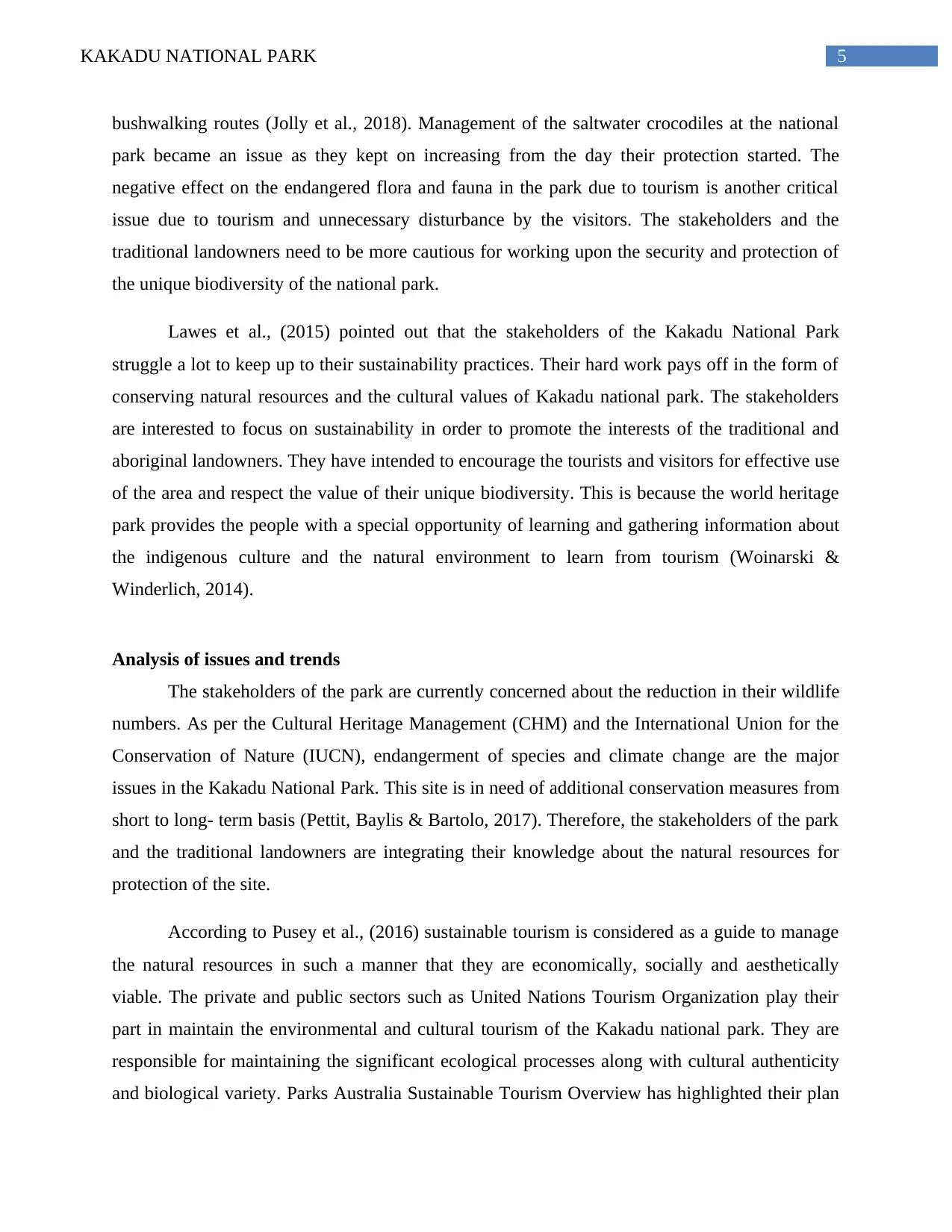
5KAKADU NATIONAL PARK
bushwalking routes (Jolly et al., 2018). Management of the saltwater crocodiles at the national
park became an issue as they kept on increasing from the day their protection started. The
negative effect on the endangered flora and fauna in the park due to tourism is another critical
issue due to tourism and unnecessary disturbance by the visitors. The stakeholders and the
traditional landowners need to be more cautious for working upon the security and protection of
the unique biodiversity of the national park.
Lawes et al., (2015) pointed out that the stakeholders of the Kakadu National Park
struggle a lot to keep up to their sustainability practices. Their hard work pays off in the form of
conserving natural resources and the cultural values of Kakadu national park. The stakeholders
are interested to focus on sustainability in order to promote the interests of the traditional and
aboriginal landowners. They have intended to encourage the tourists and visitors for effective use
of the area and respect the value of their unique biodiversity. This is because the world heritage
park provides the people with a special opportunity of learning and gathering information about
the indigenous culture and the natural environment to learn from tourism (Woinarski &
Winderlich, 2014).
Analysis of issues and trends
The stakeholders of the park are currently concerned about the reduction in their wildlife
numbers. As per the Cultural Heritage Management (CHM) and the International Union for the
Conservation of Nature (IUCN), endangerment of species and climate change are the major
issues in the Kakadu National Park. This site is in need of additional conservation measures from
short to long- term basis (Pettit, Baylis & Bartolo, 2017). Therefore, the stakeholders of the park
and the traditional landowners are integrating their knowledge about the natural resources for
protection of the site.
According to Pusey et al., (2016) sustainable tourism is considered as a guide to manage
the natural resources in such a manner that they are economically, socially and aesthetically
viable. The private and public sectors such as United Nations Tourism Organization play their
part in maintain the environmental and cultural tourism of the Kakadu national park. They are
responsible for maintaining the significant ecological processes along with cultural authenticity
and biological variety. Parks Australia Sustainable Tourism Overview has highlighted their plan
bushwalking routes (Jolly et al., 2018). Management of the saltwater crocodiles at the national
park became an issue as they kept on increasing from the day their protection started. The
negative effect on the endangered flora and fauna in the park due to tourism is another critical
issue due to tourism and unnecessary disturbance by the visitors. The stakeholders and the
traditional landowners need to be more cautious for working upon the security and protection of
the unique biodiversity of the national park.
Lawes et al., (2015) pointed out that the stakeholders of the Kakadu National Park
struggle a lot to keep up to their sustainability practices. Their hard work pays off in the form of
conserving natural resources and the cultural values of Kakadu national park. The stakeholders
are interested to focus on sustainability in order to promote the interests of the traditional and
aboriginal landowners. They have intended to encourage the tourists and visitors for effective use
of the area and respect the value of their unique biodiversity. This is because the world heritage
park provides the people with a special opportunity of learning and gathering information about
the indigenous culture and the natural environment to learn from tourism (Woinarski &
Winderlich, 2014).
Analysis of issues and trends
The stakeholders of the park are currently concerned about the reduction in their wildlife
numbers. As per the Cultural Heritage Management (CHM) and the International Union for the
Conservation of Nature (IUCN), endangerment of species and climate change are the major
issues in the Kakadu National Park. This site is in need of additional conservation measures from
short to long- term basis (Pettit, Baylis & Bartolo, 2017). Therefore, the stakeholders of the park
and the traditional landowners are integrating their knowledge about the natural resources for
protection of the site.
According to Pusey et al., (2016) sustainable tourism is considered as a guide to manage
the natural resources in such a manner that they are economically, socially and aesthetically
viable. The private and public sectors such as United Nations Tourism Organization play their
part in maintain the environmental and cultural tourism of the Kakadu national park. They are
responsible for maintaining the significant ecological processes along with cultural authenticity
and biological variety. Parks Australia Sustainable Tourism Overview has highlighted their plan

6KAKADU NATIONAL PARK
for terrestrial conservation at the national park. Apart from the public, private and the
informational sectors, cultural and environmental tourism is also enhanced by the local Bininj or
the Mungguy guides.
Cultural management tools
The cultural management tools, which were used in Kakadu National Park for
preservation of the heritage, include innovation and creativity. However, due to the limit in the
budget, these approaches will make way for future success in sustainability. Innovation and
creativity is less likely to exist in the dominance of bureaucratization prevailing in the norms and
policies of the heritage site (Russell- Smith et al., 2017). To work on the preservation of cultural
tradition and heritage and further, save the extinguished species, the park can aid the
maintenance program through proper utilization of resources. The factors and tools, which are
out of control of Kakadu such as participation in the cultural management programs and the
trans- generational shift of the sensitive cultural knowledge needs to be considered.
Stokeld et al., (2018) mentioned that for effective stakeholder management and
sustainable strategies, cultural management tools are important to incorporate in the Kakadu
national park. As the steps are being implemented to protect the wide range of biodiversity and
removing the threats of climate change, it is important to strictly adhere to the cultural roots in
case of any change or chance in the park. The stakeholders are working hard for the preservation
and at the same time, they must consider the complexity of bringing in change in the national
park (Shine et al., 2015). Following are the recommendations aimed at the improvement of the
park’s conditions.
Recommended improvement to stakeholder management
For improving stakeholder management, it can be recommended that there should be a
strong planning process for the preservation of the natural resources at the world heritage site.
The stakeholders need to be aware of the cause of the cause that they are working for and bridge
the gap in their indigenous knowledge. There are several areas, which need to be considered by
the stakeholders while working for the conservation of the Kakadu National Park. They need to
focus on the following sectors-
for terrestrial conservation at the national park. Apart from the public, private and the
informational sectors, cultural and environmental tourism is also enhanced by the local Bininj or
the Mungguy guides.
Cultural management tools
The cultural management tools, which were used in Kakadu National Park for
preservation of the heritage, include innovation and creativity. However, due to the limit in the
budget, these approaches will make way for future success in sustainability. Innovation and
creativity is less likely to exist in the dominance of bureaucratization prevailing in the norms and
policies of the heritage site (Russell- Smith et al., 2017). To work on the preservation of cultural
tradition and heritage and further, save the extinguished species, the park can aid the
maintenance program through proper utilization of resources. The factors and tools, which are
out of control of Kakadu such as participation in the cultural management programs and the
trans- generational shift of the sensitive cultural knowledge needs to be considered.
Stokeld et al., (2018) mentioned that for effective stakeholder management and
sustainable strategies, cultural management tools are important to incorporate in the Kakadu
national park. As the steps are being implemented to protect the wide range of biodiversity and
removing the threats of climate change, it is important to strictly adhere to the cultural roots in
case of any change or chance in the park. The stakeholders are working hard for the preservation
and at the same time, they must consider the complexity of bringing in change in the national
park (Shine et al., 2015). Following are the recommendations aimed at the improvement of the
park’s conditions.
Recommended improvement to stakeholder management
For improving stakeholder management, it can be recommended that there should be a
strong planning process for the preservation of the natural resources at the world heritage site.
The stakeholders need to be aware of the cause of the cause that they are working for and bridge
the gap in their indigenous knowledge. There are several areas, which need to be considered by
the stakeholders while working for the conservation of the Kakadu National Park. They need to
focus on the following sectors-
Paraphrase This Document
Need a fresh take? Get an instant paraphrase of this document with our AI Paraphraser
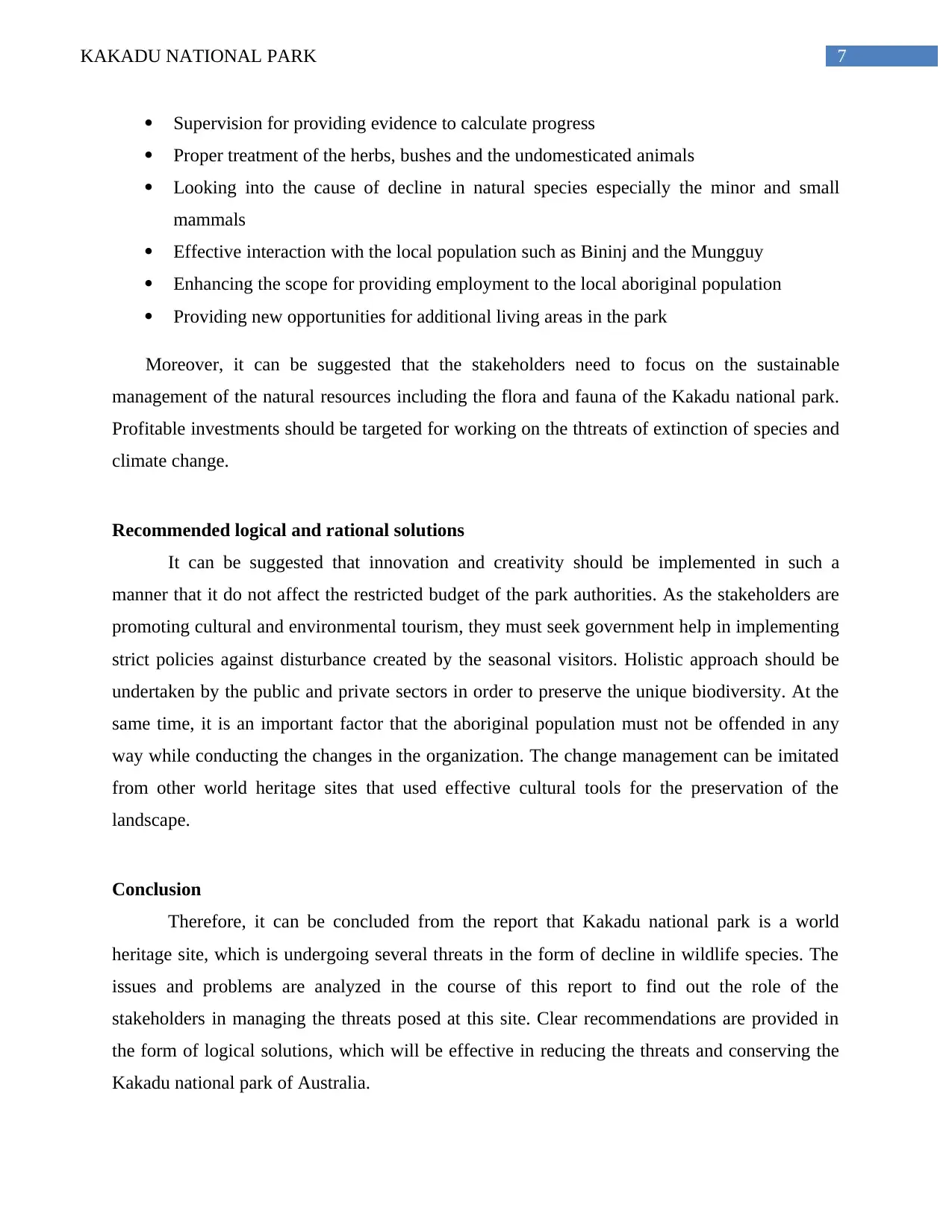
7KAKADU NATIONAL PARK
Supervision for providing evidence to calculate progress
Proper treatment of the herbs, bushes and the undomesticated animals
Looking into the cause of decline in natural species especially the minor and small
mammals
Effective interaction with the local population such as Bininj and the Mungguy
Enhancing the scope for providing employment to the local aboriginal population
Providing new opportunities for additional living areas in the park
Moreover, it can be suggested that the stakeholders need to focus on the sustainable
management of the natural resources including the flora and fauna of the Kakadu national park.
Profitable investments should be targeted for working on the thtreats of extinction of species and
climate change.
Recommended logical and rational solutions
It can be suggested that innovation and creativity should be implemented in such a
manner that it do not affect the restricted budget of the park authorities. As the stakeholders are
promoting cultural and environmental tourism, they must seek government help in implementing
strict policies against disturbance created by the seasonal visitors. Holistic approach should be
undertaken by the public and private sectors in order to preserve the unique biodiversity. At the
same time, it is an important factor that the aboriginal population must not be offended in any
way while conducting the changes in the organization. The change management can be imitated
from other world heritage sites that used effective cultural tools for the preservation of the
landscape.
Conclusion
Therefore, it can be concluded from the report that Kakadu national park is a world
heritage site, which is undergoing several threats in the form of decline in wildlife species. The
issues and problems are analyzed in the course of this report to find out the role of the
stakeholders in managing the threats posed at this site. Clear recommendations are provided in
the form of logical solutions, which will be effective in reducing the threats and conserving the
Kakadu national park of Australia.
Supervision for providing evidence to calculate progress
Proper treatment of the herbs, bushes and the undomesticated animals
Looking into the cause of decline in natural species especially the minor and small
mammals
Effective interaction with the local population such as Bininj and the Mungguy
Enhancing the scope for providing employment to the local aboriginal population
Providing new opportunities for additional living areas in the park
Moreover, it can be suggested that the stakeholders need to focus on the sustainable
management of the natural resources including the flora and fauna of the Kakadu national park.
Profitable investments should be targeted for working on the thtreats of extinction of species and
climate change.
Recommended logical and rational solutions
It can be suggested that innovation and creativity should be implemented in such a
manner that it do not affect the restricted budget of the park authorities. As the stakeholders are
promoting cultural and environmental tourism, they must seek government help in implementing
strict policies against disturbance created by the seasonal visitors. Holistic approach should be
undertaken by the public and private sectors in order to preserve the unique biodiversity. At the
same time, it is an important factor that the aboriginal population must not be offended in any
way while conducting the changes in the organization. The change management can be imitated
from other world heritage sites that used effective cultural tools for the preservation of the
landscape.
Conclusion
Therefore, it can be concluded from the report that Kakadu national park is a world
heritage site, which is undergoing several threats in the form of decline in wildlife species. The
issues and problems are analyzed in the course of this report to find out the role of the
stakeholders in managing the threats posed at this site. Clear recommendations are provided in
the form of logical solutions, which will be effective in reducing the threats and conserving the
Kakadu national park of Australia.

8KAKADU NATIONAL PARK
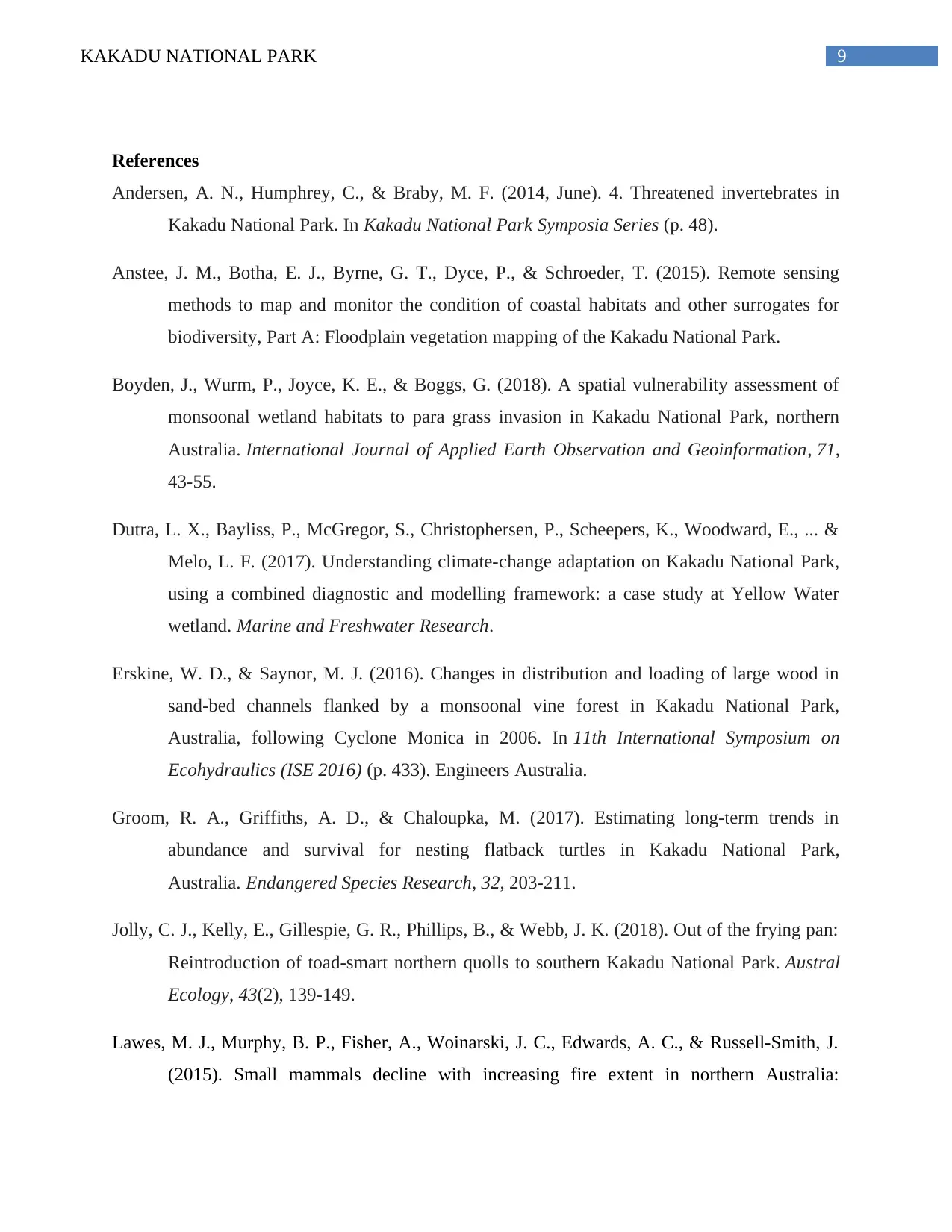
9KAKADU NATIONAL PARK
References
Andersen, A. N., Humphrey, C., & Braby, M. F. (2014, June). 4. Threatened invertebrates in
Kakadu National Park. In Kakadu National Park Symposia Series (p. 48).
Anstee, J. M., Botha, E. J., Byrne, G. T., Dyce, P., & Schroeder, T. (2015). Remote sensing
methods to map and monitor the condition of coastal habitats and other surrogates for
biodiversity, Part A: Floodplain vegetation mapping of the Kakadu National Park.
Boyden, J., Wurm, P., Joyce, K. E., & Boggs, G. (2018). A spatial vulnerability assessment of
monsoonal wetland habitats to para grass invasion in Kakadu National Park, northern
Australia. International Journal of Applied Earth Observation and Geoinformation, 71,
43-55.
Dutra, L. X., Bayliss, P., McGregor, S., Christophersen, P., Scheepers, K., Woodward, E., ... &
Melo, L. F. (2017). Understanding climate-change adaptation on Kakadu National Park,
using a combined diagnostic and modelling framework: a case study at Yellow Water
wetland. Marine and Freshwater Research.
Erskine, W. D., & Saynor, M. J. (2016). Changes in distribution and loading of large wood in
sand-bed channels flanked by a monsoonal vine forest in Kakadu National Park,
Australia, following Cyclone Monica in 2006. In 11th International Symposium on
Ecohydraulics (ISE 2016) (p. 433). Engineers Australia.
Groom, R. A., Griffiths, A. D., & Chaloupka, M. (2017). Estimating long-term trends in
abundance and survival for nesting flatback turtles in Kakadu National Park,
Australia. Endangered Species Research, 32, 203-211.
Jolly, C. J., Kelly, E., Gillespie, G. R., Phillips, B., & Webb, J. K. (2018). Out of the frying pan:
Reintroduction of toad‐smart northern quolls to southern Kakadu National Park. Austral
Ecology, 43(2), 139-149.
Lawes, M. J., Murphy, B. P., Fisher, A., Woinarski, J. C., Edwards, A. C., & Russell-Smith, J.
(2015). Small mammals decline with increasing fire extent in northern Australia:
References
Andersen, A. N., Humphrey, C., & Braby, M. F. (2014, June). 4. Threatened invertebrates in
Kakadu National Park. In Kakadu National Park Symposia Series (p. 48).
Anstee, J. M., Botha, E. J., Byrne, G. T., Dyce, P., & Schroeder, T. (2015). Remote sensing
methods to map and monitor the condition of coastal habitats and other surrogates for
biodiversity, Part A: Floodplain vegetation mapping of the Kakadu National Park.
Boyden, J., Wurm, P., Joyce, K. E., & Boggs, G. (2018). A spatial vulnerability assessment of
monsoonal wetland habitats to para grass invasion in Kakadu National Park, northern
Australia. International Journal of Applied Earth Observation and Geoinformation, 71,
43-55.
Dutra, L. X., Bayliss, P., McGregor, S., Christophersen, P., Scheepers, K., Woodward, E., ... &
Melo, L. F. (2017). Understanding climate-change adaptation on Kakadu National Park,
using a combined diagnostic and modelling framework: a case study at Yellow Water
wetland. Marine and Freshwater Research.
Erskine, W. D., & Saynor, M. J. (2016). Changes in distribution and loading of large wood in
sand-bed channels flanked by a monsoonal vine forest in Kakadu National Park,
Australia, following Cyclone Monica in 2006. In 11th International Symposium on
Ecohydraulics (ISE 2016) (p. 433). Engineers Australia.
Groom, R. A., Griffiths, A. D., & Chaloupka, M. (2017). Estimating long-term trends in
abundance and survival for nesting flatback turtles in Kakadu National Park,
Australia. Endangered Species Research, 32, 203-211.
Jolly, C. J., Kelly, E., Gillespie, G. R., Phillips, B., & Webb, J. K. (2018). Out of the frying pan:
Reintroduction of toad‐smart northern quolls to southern Kakadu National Park. Austral
Ecology, 43(2), 139-149.
Lawes, M. J., Murphy, B. P., Fisher, A., Woinarski, J. C., Edwards, A. C., & Russell-Smith, J.
(2015). Small mammals decline with increasing fire extent in northern Australia:
Secure Best Marks with AI Grader
Need help grading? Try our AI Grader for instant feedback on your assignments.
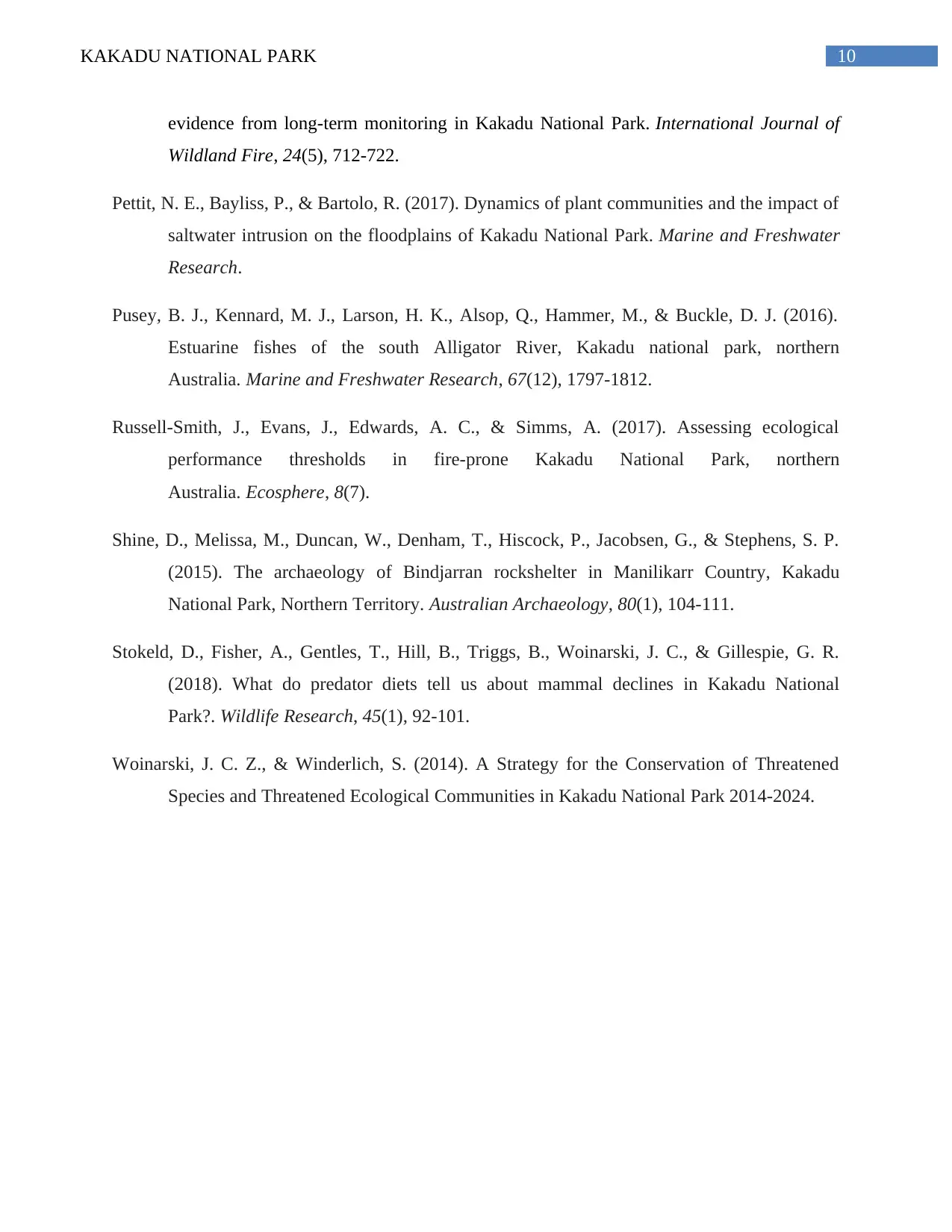
10KAKADU NATIONAL PARK
evidence from long-term monitoring in Kakadu National Park. International Journal of
Wildland Fire, 24(5), 712-722.
Pettit, N. E., Bayliss, P., & Bartolo, R. (2017). Dynamics of plant communities and the impact of
saltwater intrusion on the floodplains of Kakadu National Park. Marine and Freshwater
Research.
Pusey, B. J., Kennard, M. J., Larson, H. K., Alsop, Q., Hammer, M., & Buckle, D. J. (2016).
Estuarine fishes of the south Alligator River, Kakadu national park, northern
Australia. Marine and Freshwater Research, 67(12), 1797-1812.
Russell‐Smith, J., Evans, J., Edwards, A. C., & Simms, A. (2017). Assessing ecological
performance thresholds in fire‐prone Kakadu National Park, northern
Australia. Ecosphere, 8(7).
Shine, D., Melissa, M., Duncan, W., Denham, T., Hiscock, P., Jacobsen, G., & Stephens, S. P.
(2015). The archaeology of Bindjarran rockshelter in Manilikarr Country, Kakadu
National Park, Northern Territory. Australian Archaeology, 80(1), 104-111.
Stokeld, D., Fisher, A., Gentles, T., Hill, B., Triggs, B., Woinarski, J. C., & Gillespie, G. R.
(2018). What do predator diets tell us about mammal declines in Kakadu National
Park?. Wildlife Research, 45(1), 92-101.
Woinarski, J. C. Z., & Winderlich, S. (2014). A Strategy for the Conservation of Threatened
Species and Threatened Ecological Communities in Kakadu National Park 2014-2024.
evidence from long-term monitoring in Kakadu National Park. International Journal of
Wildland Fire, 24(5), 712-722.
Pettit, N. E., Bayliss, P., & Bartolo, R. (2017). Dynamics of plant communities and the impact of
saltwater intrusion on the floodplains of Kakadu National Park. Marine and Freshwater
Research.
Pusey, B. J., Kennard, M. J., Larson, H. K., Alsop, Q., Hammer, M., & Buckle, D. J. (2016).
Estuarine fishes of the south Alligator River, Kakadu national park, northern
Australia. Marine and Freshwater Research, 67(12), 1797-1812.
Russell‐Smith, J., Evans, J., Edwards, A. C., & Simms, A. (2017). Assessing ecological
performance thresholds in fire‐prone Kakadu National Park, northern
Australia. Ecosphere, 8(7).
Shine, D., Melissa, M., Duncan, W., Denham, T., Hiscock, P., Jacobsen, G., & Stephens, S. P.
(2015). The archaeology of Bindjarran rockshelter in Manilikarr Country, Kakadu
National Park, Northern Territory. Australian Archaeology, 80(1), 104-111.
Stokeld, D., Fisher, A., Gentles, T., Hill, B., Triggs, B., Woinarski, J. C., & Gillespie, G. R.
(2018). What do predator diets tell us about mammal declines in Kakadu National
Park?. Wildlife Research, 45(1), 92-101.
Woinarski, J. C. Z., & Winderlich, S. (2014). A Strategy for the Conservation of Threatened
Species and Threatened Ecological Communities in Kakadu National Park 2014-2024.
1 out of 11
Related Documents
Your All-in-One AI-Powered Toolkit for Academic Success.
+13062052269
info@desklib.com
Available 24*7 on WhatsApp / Email
![[object Object]](/_next/static/media/star-bottom.7253800d.svg)
Unlock your academic potential
© 2024 | Zucol Services PVT LTD | All rights reserved.




